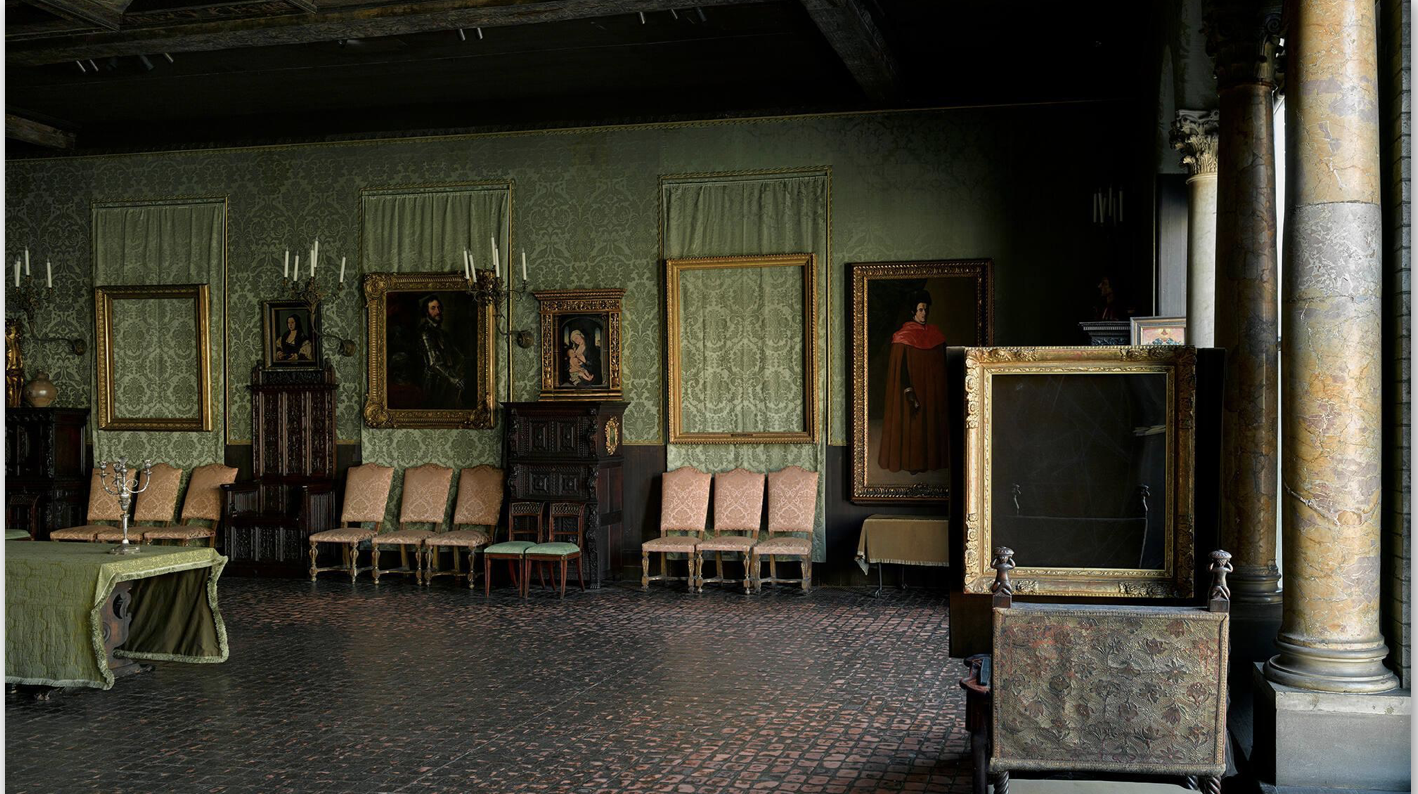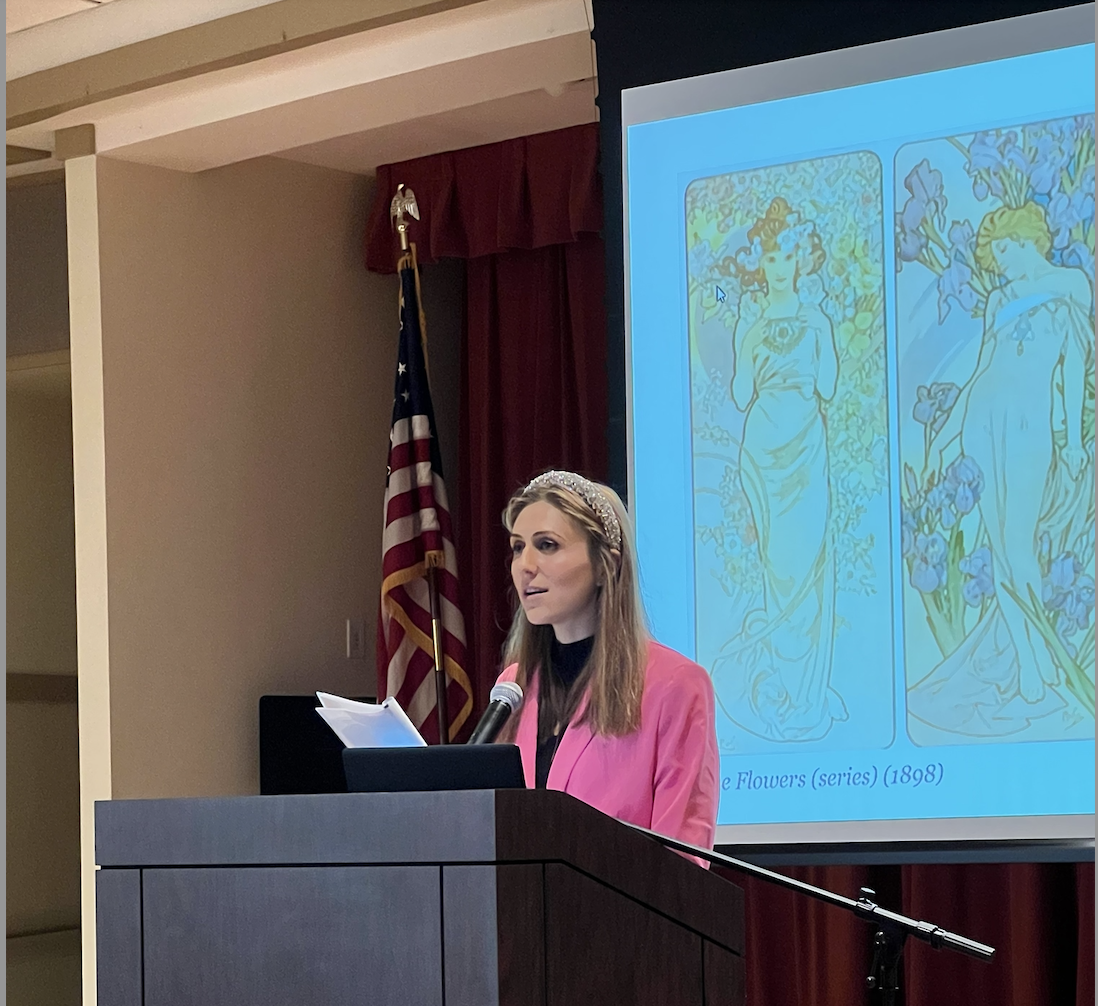by Amineddoleh & Associates LLC | Jul 27, 2023 |
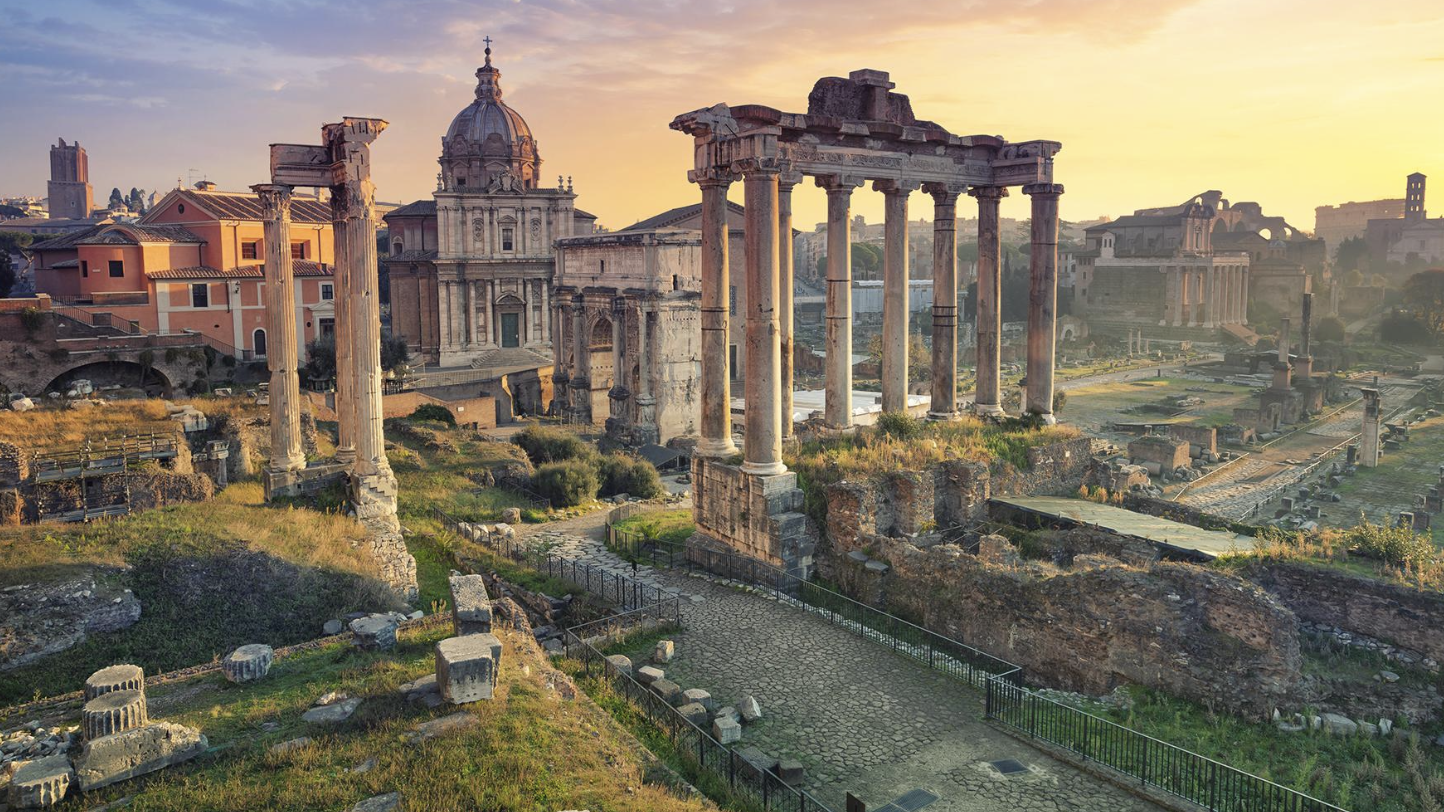
Roman Forum. Image via Fodor’s, available at https://www.fodors.com/world/europe/italy/rome/experiences/news/photos/the-10-best-ancient-sites-in-rome.
Our firm is pleased to continue our collaboration with the American Institute for Roman Culture (AIRC) in their Ancient Rome Live Series. Those familiar with the AIRC’s work will remember our firm’s past contributions to the series, which are available here.
For those who are just learning of AIRC and their work, the AIRC is an internationally-acclaimed non-profit founded in 2002 to promote Italian culture. AIRC provides opportunities for education, archeology, and study abroad, with locations in both the U.S. and Italy. AIRC’s founder, Darius A. Arya, is an archeologist, public historian, author, social media influencer, and TV host based in Rome, Italy. In his role as AIRC CEO, Dr. Arya leads lecture series, heritage preservation initiatives, teaches bespoke educational courses, and hosts a highly-rated podcast called Darius Arya Digs.
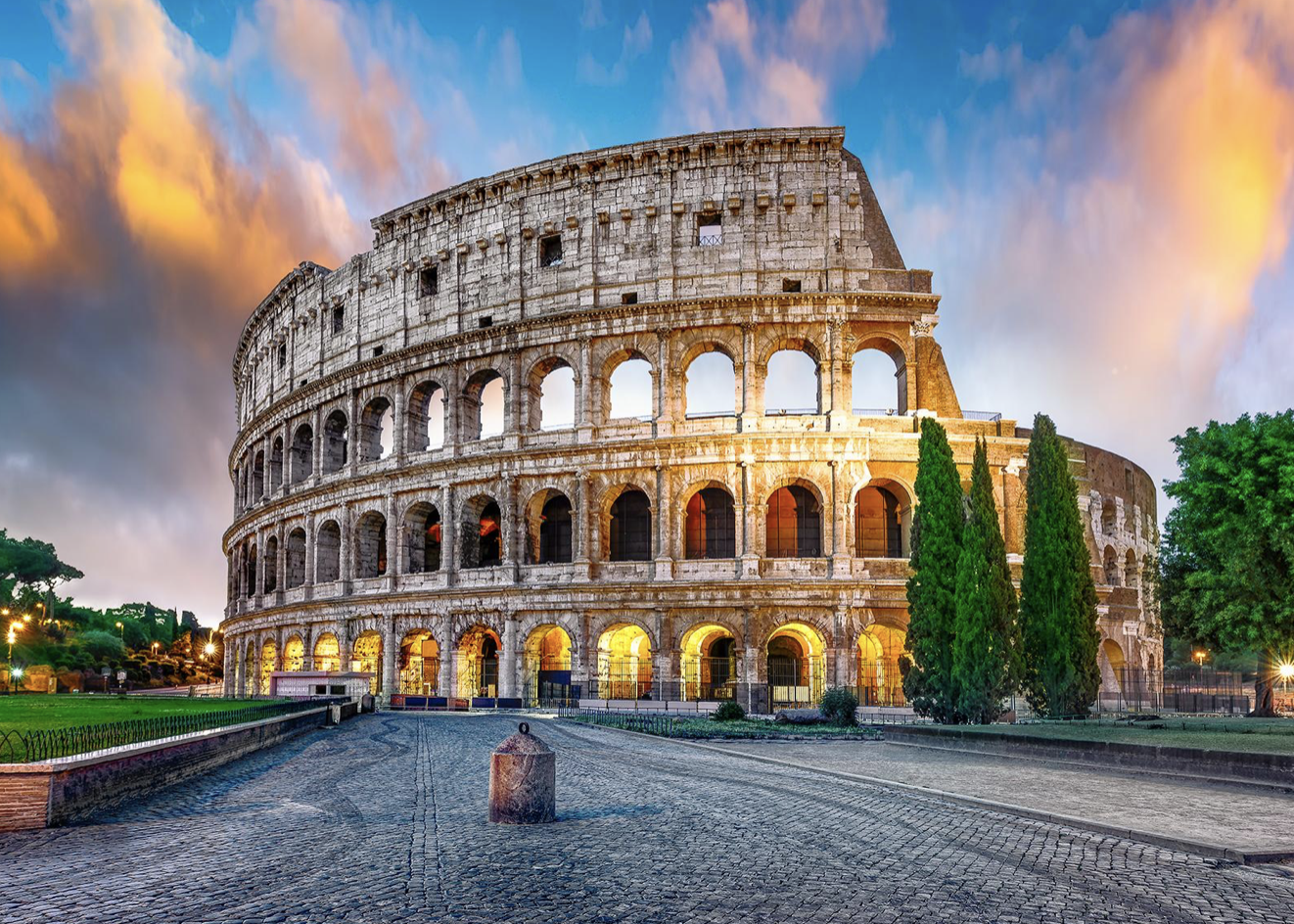
Colosseum. Image via Fodor’s, available at https://www.fodors.com..
Our firm’s most recent contribution tackles the complicated (and extremely timely) issue of overtourism. Following the opening of international borders, tourists have flocked to cultural heritage hotspots around the globe. The sudden influx of tourism to cultural heritage sites seems to be a symptom of “revenge tourism,” the product of isolating at home during the pandemic. While re-engaging with travel in a thoughtful way no doubt fuels local economies and broadens the mind, thoughtless travel often results in the destruction of priceless pieces of cultural heritage.
Interested? Read the entire article on the Ancient Rome Live Series website, here.
AIRC has been an awarded an NEH grant, an American Express Foundation grant, and a World Monuments Fund (WMF) collaboration. AIRC receives additional funding from anonymous angel investors and individual donors. If you would like to contribute to AIRC and Dr. Arya’s world-class courses and promote opportunities for lifelong learning, you may support the organization here.
by Amineddoleh & Associates LLC | Jul 24, 2023 |
Art Nouveau fans rejoice: July 24th is the late Alphonse Mucha’s birthday. This year’s anniversary comes with a bit less fanfare than his 150th in 2010, when Google created a doodle on the artist’s behalf.
But even without a doodle from Google, Mucha’s legacy continues to influence art and artists around the world. One aspect of his enduring legacy is how his work influenced the rise of celebrity art. This phenomenon has been popping up more and more frequently in American culture, and no one (not even celebrities themselves) are immune from the draw of star power.
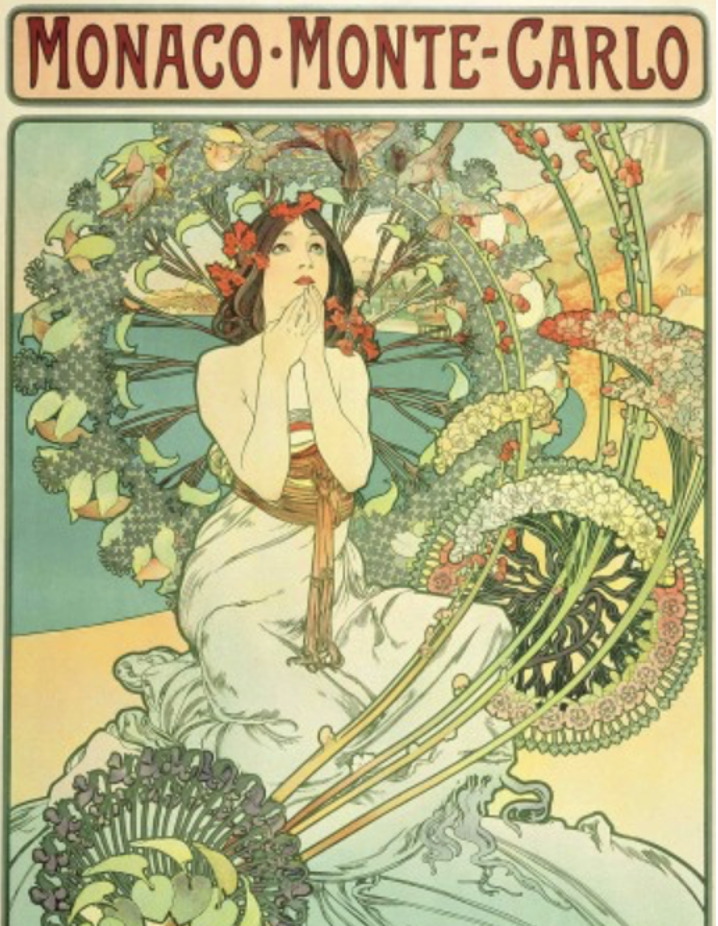
Modern Celebrities Embrace Art
No longer playing the role of pirate, actor Johnny Depp has swapped his sword for a paintbrush in real-life. It seems to have been a sound business move. The actor made a staggering $3.6 million selling works from his first “Friends & Heroes” art collection in 2022. His second, entitled “Friends & Heroes II” was released in February. It is comprised of four portraits of artists that have inspired Depp throughout his life: Bob Marley, Health Ledger, River Phoenix, and Hunter S. Thompson. An unbelievable answer to the classic “Dream guests at a dinner party?” question, if ever one existed. Almost already entirely sold out – all that remains on the Castle Fine Art website is a pack of all four prints, priced at a swashbuckling $20,416.67.
Depp’s foray into celebrity art highlights modern culture’s fascination with all-things celebrity. Are Depp’s works prized due to his creative talent as an artist? Or are the pieces selling because they are exclusively of famous celebrities? Or, possibly, Depp is able to sell out faster than Taylor Swift tickets because he, himself, is a celebrity? Which points to the threshold question: when did artists begin to feature celebrities in art? Many art historians look no further than the incredibly gifted Alphonse Mucha, who skyrocketed his own career to greater heights through his collaboration with a famous actress.
Rise of Celebrity Art
“If you have to explain to someone you’re famous, then you’re technically not that famous.”- David Spade.
The beauty of Alphonse Mucha‘s work stems from his deep passion as an artist. Many artists are known for having a lot of gusto, but Mucha really takes the cake. He was master of the Art Nouveau style of art, so masterful in fact that many credit his career for influencing major tenants of the age – politics, religion, philosophy, and – of all things – the career of one very famous actress named Sarah Bernhardt.
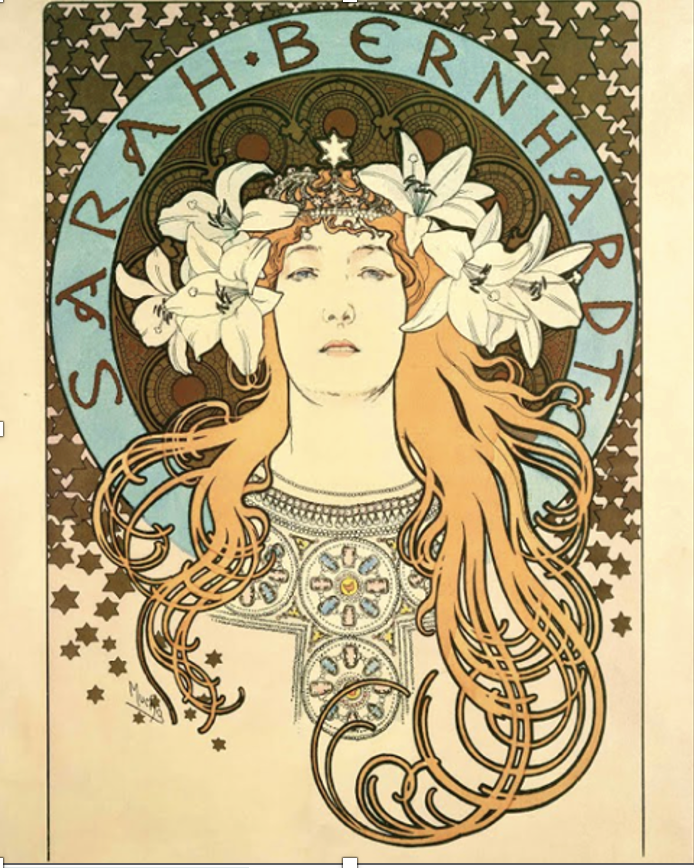
Alphonse Mucha, Poster for ‘La Plume’ magazine (1897). Image via muchafoundation.org.
Before we get to Sarah, a little more about our man Mucha. He was born on July 24, 1860, in a quiet town in Moravia. In his youth, Mucha was – in his own words – “preoccupied with observing.” This tendency to notice things around him manifested in a profound artistic talent. Young Mucha could be found making sketches and drawings for friends, family, and fellow townsfolk. His drawings were so prodigious that he collected quite a few fans, even in his early days. One fan was the town’s shopkeeper, who often slipped Mucha free sheets of a paper – a luxury of the day – in order for him to make his creations.
As Mucha grew older, his artistic talent also matured. When he was 18, he was ready to apply to the Academy of Fine Arts in Prague. Unfortunately, he was rejected. The admissions office even went as far to suggest he take up a different, “less artistic” career. I’m not sure what they had in mind (medical school?), but fortunately for us, Mucha was not discouraged for long. He decided to simply carry on and continued to make art in whatever way he could.
A year later, Mucha had a bit of luck – an opportunity arose for an artist to work with a Vienna newspaper making advertisements. The pay was pitiful, and Vienna is freezing cold in winter. However, Mucha forged ahead, desperate to create. He applied, scored the gig, and packed his bags for his journey to the big city.
This was a turning point in Mucha’s development as an artist. He spent two years in Vienna, creating advertisements for the paper by day and taking art classes by night. What this did was cement in him a love for creating artwork that was accessible to the average, everyday person. He thrived on creating beauty in pamphlets, posters, and advertisements that most companies and institutions did not have the time or talent to make elaborate. We can start to see, from this period, the development of certain curvature in his lines, and repetition of old world-inspired motifs come up again and again in works that would inevitably become a part of an ordinary person’s daily life.
Mucha retained this love of creating beautiful and accessible work, while still seeking to enhance his skill as an artist through more formal training. Eventually, he applied to – and was accepted to enroll in – the Academy of Fine Arts in Munich in September of 1885. This provided Mucha with formal artistic skills, though it is important to note that Mucha is still believed to be largely self-taught as an artist (which could also mean that he ignored much of what was taught in school). From Munich, he made his way to Paris: the art capital of the world at the time.
In the City of Lights, he established himself as a “reliable” illustrator (as noted by his biographers). The Paris theater scene is where the lives of Mucha and the phenom Sarah Bernhardt intersect. Sarah Bernhardt is often touted as the original “true superstar.” This is before the current fame-cycle of Hollywood starlets, who now can be seen as a dime a dozen, splashed across the covers of People magazine.
Sarah Bernhardt was the real-deal – a woman with the poise, charisma, and gumption to make a name for herself as an actress against the backdrop of a politically tumultuous city. Not only is she remembered as a strikingly impactful actress, known for her talent, she is also regarded as the first superstar known to personally exploit her own image and likeness for economic gain, and to raise her own fame. This is an important piece of the puzzle of a topic referred to as “publicity,” which we’ll address later.
Mucha began working with Bernhardt in December 1894, in a serendipitous sort of meeting that can only be attributed to fate. Bernhardt’s play, Gismonda, was set to open on January 4th, 1895. On December 26th, 1894 – just a few short days before opening night – the starlet decided that her show needed a new poster to publicize the play. Something dazzling. Something that would leave Paris speechless.
She turned to the manager of a Parisian printing firm for a new poster, pronto. Given the short notice, and the fact that Bernhardt approached the firm in the middle of the Christmas break, Maurice was short on options for the commission. In desperation, he turned to Mucha – truly the only option at hand – and begged him to take on the job. Ever the flexible type, Mucha agreed. And, in doing so, a true collaboration between two legendary artists was born.
The success of Mucha and Bernhardt’s eventual career-long collaboration is likely because the two saw eye-to-eye on Sarah’s talent.
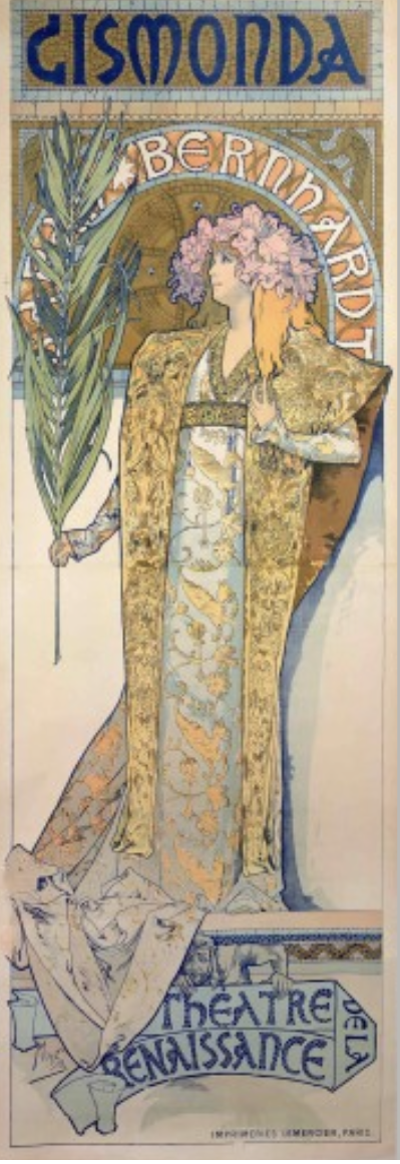
Alphonse Mucha, Poster for ’Gismonda’ (1894). Image via muchafoundation.org.
In other words, Mucha was a fan. In creating the poster for Gismonda, he relied on his personal knowledge of the play itself, as well as his fascination with how Bernhardt depicted the title role. The result? A stunningly ethereal piece that focused the viewer of the poster on the actress herself, rather than on fussy knickknacks in the background. The poster was truly a spotlight on Sarah, in all her glory – and Sarah loved it.
Thus, the two kicked off a mutually beneficial partnership. Bernhardt became Mucha’s artistic muse and mentor in the industry. They also became very good friends. Each seemed impressed by the other’s commitment to creativity, and fervent refusal to be fenced in by artistic norms of the day. Sarah, for her part, pushed the boundaries of Parisian theater by lobbying for politically impactful roles. Mucha, on his end, blazed a trail as a high-end artist for the lower strata of society.
Much of the work Mucha did for Sarah was accessible to the everyday Parisian, because her giant posters were displayed on the street. And, he created many posters of Bernhardt in her various roles throughout the remainder of her career. Because Mucha continued to make Bernhardt the star of each new poster, his work served to elevate her career to even greater heights. In this way, Bernhardt was able to exploit her own image and likeness to increase her status as a public figure – and was one of the first known celebrities to ever do so.
The upside for Mucha was that, because of his work that featured Sarah, he became higher-in-demand as an artist for other jobs. Mucha became more famous and earned more money because he painted someone famous.
Collaboration v. Exploitation
Mucha’s portrayals of Sarah Bernhardt in his artwork were clearly a collaboration. But, using a celebrity’s image in a work of art does bring forth a question: when can an artist legally make use of a person’s image or likeness in a work of art, if use of that image increases the economic value of the work itself?
Modern Legal Framework & Application
To answer this question, two rights come into play. Both come from state, rather than federal law, and are mostly understood through case law.
The first right is called the right of privacy. This means is that private people have the right to prevent the public disclosure of their name and likeness by others. For example, if a company started using a private person’s face as the logo for a brand of salad dressing, that person could bring an action against that company claiming the right of privacy.
The second right, which sounds similar, but functions very differently, is called the right of publicity. That right means that a person has the right to exploit her own image and likeness for her own economic gain. Using the salad dressing example, this is why “Newman’s Own” salad dressing uses his face on the label. His company profits from the use of his public image on its products. The right belongs to Newman’s heirs, because the value of his image is the fruit of his own hard work as a famous actor. (Confusingly, what is referred to as the right of privacy in New York is, in fact, the right of publicity).
Sometimes, the aforementioned rules change if, instead of, as in the example, an advertiser using the celebrity’s image, the person using the celebrity’s image is an artist creating a work of art.
Some courts have held that any work created by an artist, even if it uses a celebrity’s image, is a form of free expression. The First Amendment protects free speech. Included in the many categories of free speech is art – it’s speech, even if it doesn’t make noise.
Courts that have broadly interpreted the First Amendment free speech protection in cases where an artist uses a celebrity’s image in their art have generally permitted it. According to these courts, if artist’s use of the celebrity image is a form of free speech, it is allowed. However, the application of this principle is not as straightforward as it might appear. While some courts have given artists broad discretion under the First Amendment to use celebrities in their works, other courts have sided with celebrity defendants, under the theory that the artist’s work violates the celebrity’s right of publicity.
by Amineddoleh & Associates LLC | Apr 13, 2023 |
At 6:30pm on Monday evening, April 15, 2019, the Cathedral of Notre-Dame de Paris began to burn.
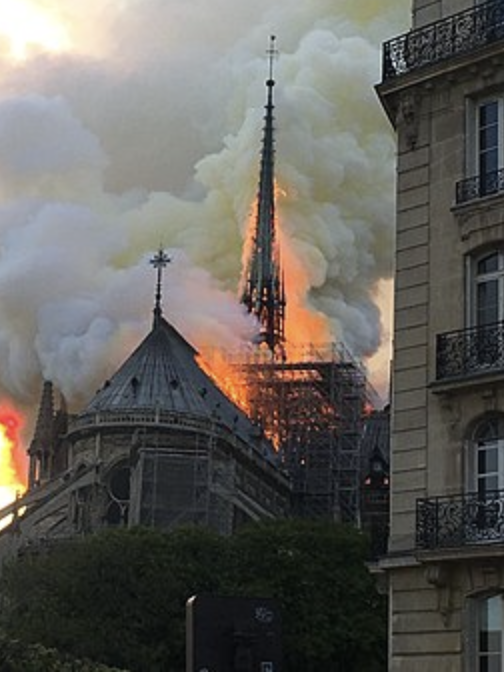
Notre-Dame Cathedral’s spire on fire on April 15, 2019. Image courtesy Antoninnnnn via Wikimedia Commons.
Considered a jewel of Gothic architecture, the inferno began in what has been referred to as the “forest” of wooden beams inside the Cathedral’s roof. These beams caught fire and collapsed – a big issue, because the wooden forest of beams had provided much-needed support for the entire structure. After the beams disintegrated, the Cathedral crumbled. Onlookers, who yearned for the building to be saved from disaster, lost hope. As the Cathedral sank, smoke and dust rose to overtake the horizon.
Four years later, the darkness has cleared and hope abounds. The shock felt by millions around the world has softened, and the Cathedral’s on-going renovation is chugging along like the Little Engine that Could.
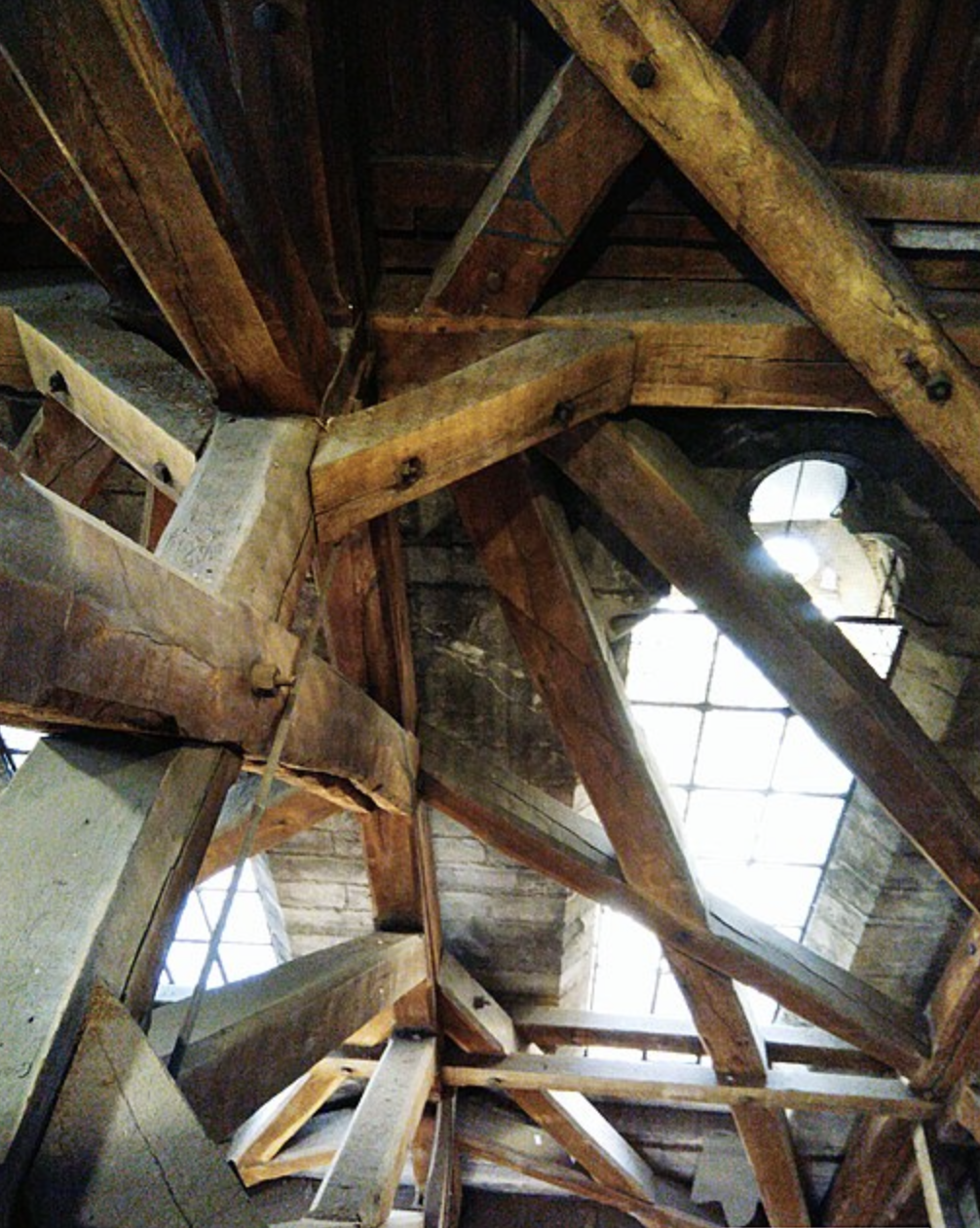
The inner framework of Notre-Dame, just months before the 2019 fire. Image courtesy SamuelPrr14 via Wikimedia Commons.
However, this chugging along is certainly that – a slow, steady pace. Originally, an anticipated re-opening date was set for April 19, 2024. This date would have been ideal as it is the fifth anniversary of the fire. Yet, due to delays, that plan has been scrapped. Several things have gotten in the way of the original timeframe (two major ones being a global pandemic and the outbreak of war in Ukraine).
Renovators, seeing that the finish line was not quite in sight to make that deadline, made adjustments. “Plan B” was to have the project finished by the summer of 2024. This would have meant that the reveal of refreshed cathedral would coincide with Paris’s highly anticipated 2024 Summer Olympic Games. Unfortunately, that plan has also been scrapped and tossed in the rubble. The newest official re-opening goal date is set for December 2024.
However, it is important to understand what “re-opening” entails. December 2024 is unlikely to mark the completion of all necessary renovations. Total completion by this date is not the goal; rather, it is to have the space ready to celebrate Catholic Mass by that time. As Culture Minister Rima Abdul-Malak explained, while tourists will be able to visit the site in late 2024 and attend Mass, renovations will continue into 2025.
Does it seem strange to celebrate Catholic liturgy in a half-finished construction site? Perhaps, but the French are the ultimate authority on the “chic, messy effortlessness” that results from a project left not-quite-done. Plus, those feeling impatient may quench their thirst for Notre-Dame de Paris by arriving in Paris, post-haste! A new exhibition has opened, entitled “Notre-Dame de Paris: at the heart of the construction site.” Visitors can expect to reap the inside scoop of the on-going renovation, plus view some remains from the fire, as well as salvaged artwork from the Cathedral.
In truth, the delays that have pushed back the opening, and made the aforementioned exhibit possible, are likely a good sign. The extended time for renovations signifies the seriousness and care being put into this renovation by the expert team on the ground in Paris. This is not surprising, seeing that the Cathedral is a highlight along tourists’ itineraries, and the structure has inspired generations of artists and writers.
The situation is as poet Mary Oliver wrote: “Things take the time they take. Don’t worry. How many roads did St. Augustine travel, before he became St. Augustine?”
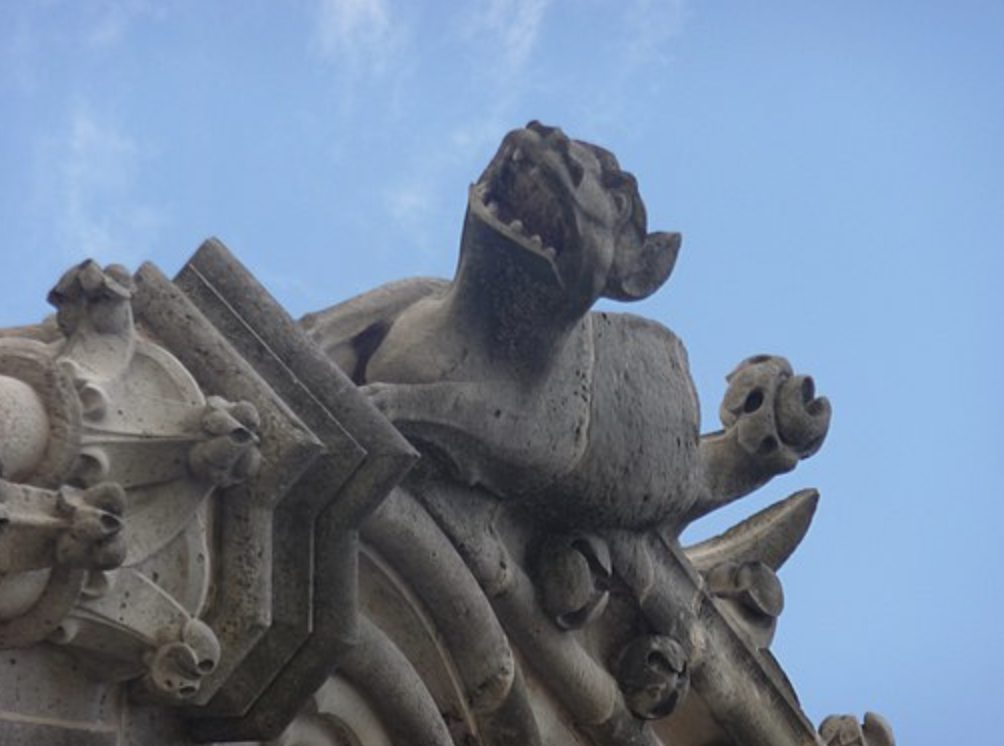
One of the classic gargoyles atop Notre-Dame, photographed in 2016. Image courtesy Marcok via Wikimedia Commons.
Who is the genius leading this team of experts? The man entrusted with this special renovation project is none other than famed architect Philippe Villeneuve. According to Paris’s Official Tourism site, Villeneuve’s plan from the get-go has been to “rebuild the cathedral identically, including the spire.” The architect’s mission to retain the building’s original structure seems to be the foundation from which all other decisions are made. Even so, some of the plans have departed from the Cathedral’s original design. This has caused quite a bit of drama. The reason for the drama is that, unsurprisingly, there have been a lot of opinions about how the phoenix of Notre-Dame de Paris should rise from the ashes.
The online rumor mill has added fuel to the fire. Last year, rumors surfaced regarding plans to depart from the Cathedral’s original plans, sacrificing austerity for new tech and additional features. This caused widespread concern among art experts and historians that the Diocese of Paris was attempting its own “woke Disney revamp.” Plans to create features such as “emotional spaces” and “a discovery tour” sparked French academics to doom the proposals as an example of “inanity [meeting] kitsch.”
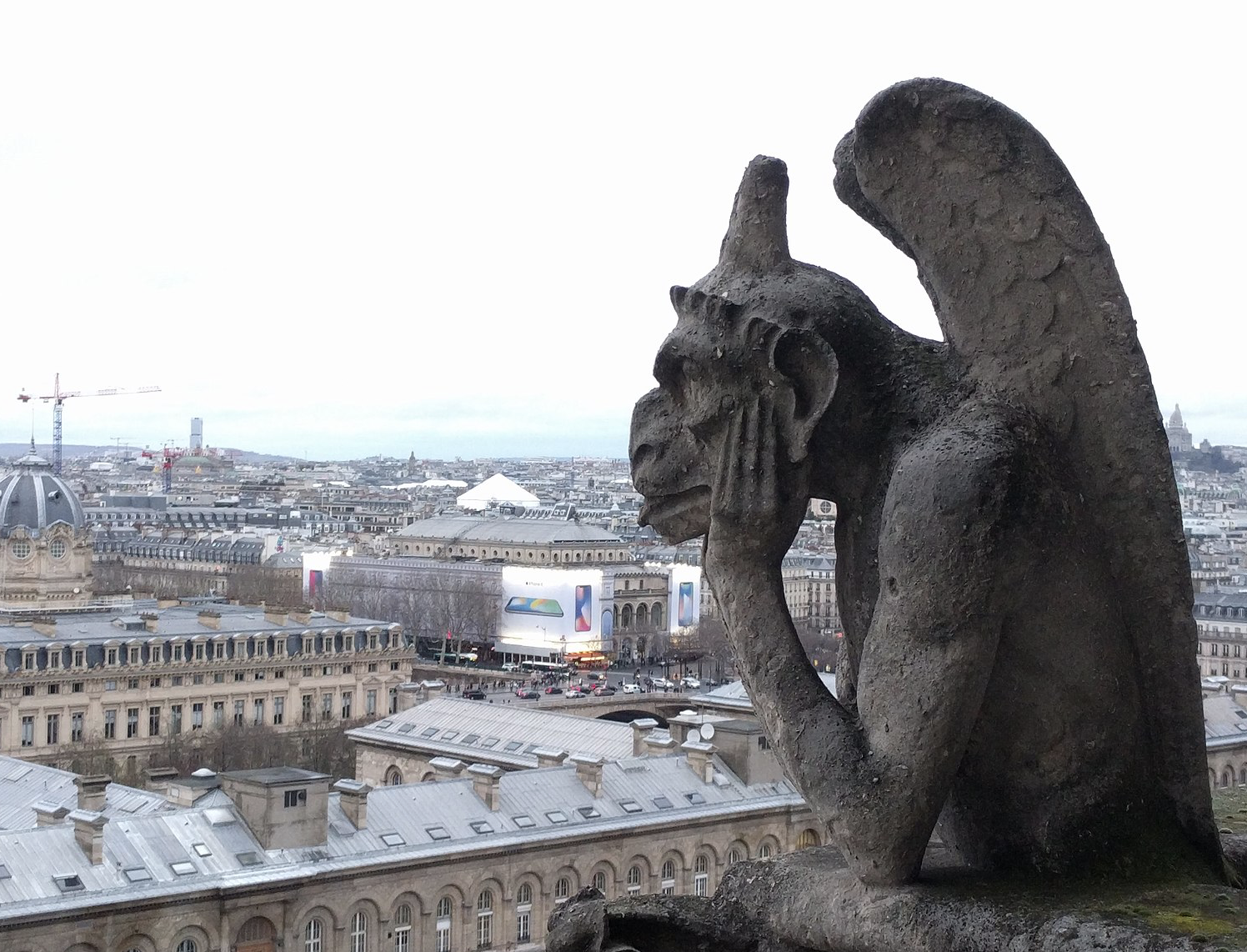
A contemplative gargoyle on the North Bell Tower in 2018, perhaps foreseeing the coming fire. Image courtesy Mari Doucet via Wikimedia Commons.
The “woke Disney revamp” comments ironically threw serious shade on the media powerhouse that brought new fame to Notre-Dame in the 1990s with the release of the animated film The Hunchback of Notre Dame. When approached for comment about the unfavorable comparison, Mr. Mickey Mouse chose not to respond. Those familiar with the matter claim that Mr. Mouse had suggested sending a “poop emoji” to the art historians’ to counter the vitriolic attack, but was dissuaded by publicity experts from doing so.
Despite criticism of any change from the original design, France’s National Heritage and Architecture Commission has approved several proposals integrating modern updates. These include installing modern lighting and contemporary works. Strong adherents to the traditional Gothic integrity of the space oppose such changes; on the other side, the Cathedral’s pastoral staff claim that some changes to the original plan will make the experience of visiting the Cathedral more enjoyable overall.
Additional controversial proposed changes favored by the Diocese include moving the tabernacle and other sacred objects. The purpose behind these changes is to encourage more of a dialogue between the visitor and the Gothic architecture of the sacred space when walking through the space. French authorities hope that these changes will retain the traditional feel of the original layout, while “bringing more a little more sense to the visitor.” As these changes seem directed at easing crowd flow for when the Cathedral is once again a major tourist site, they have faced fewer critics.
Lookout for the Spire
When word broke loose that there were plans to significantly change the monument’s overall architecture, the French Government got involved, to make sure that crucial elements of the Cathedral remain the same. At one point, a change to the iconic look of Notre-Dame was suggested in the form of a new, more modern spire. In response, President Emmanuel Macron intervened. He had been approached by cultural heritage experts who convinced him that a dramatic overhaul in design would drastically alter the integrity of the globally recognized monument. Macron stepped in to nix the change and prevent the 19th-century spire from being replaced with a more contemporary update. Reconstruction of the spire did not start until last year, because the monument itself had to undergo significant reconstruction to be able to support the 315 ft spire. True to his word, Macron has ensured that the new spire will match the one lost by fire. Those scanning the Parisian skyline will once again see the fabled towers in renewed glory.
A History of Renovations
Many people will be surprised to learn that the so-fought-for spire was not, in fact, part of the original 12th century Gothic design. The iconic Notre-Dame de Paris spire that the world knows and loves was added in the 19th century, by architect Eugène Voillet-le-Duc. Voillet-le-Duc’s involvement was the result of a major renovation effort at that time, spurred into life by renewed interest in the Cathedral following Victor Hugo’s famed tale.
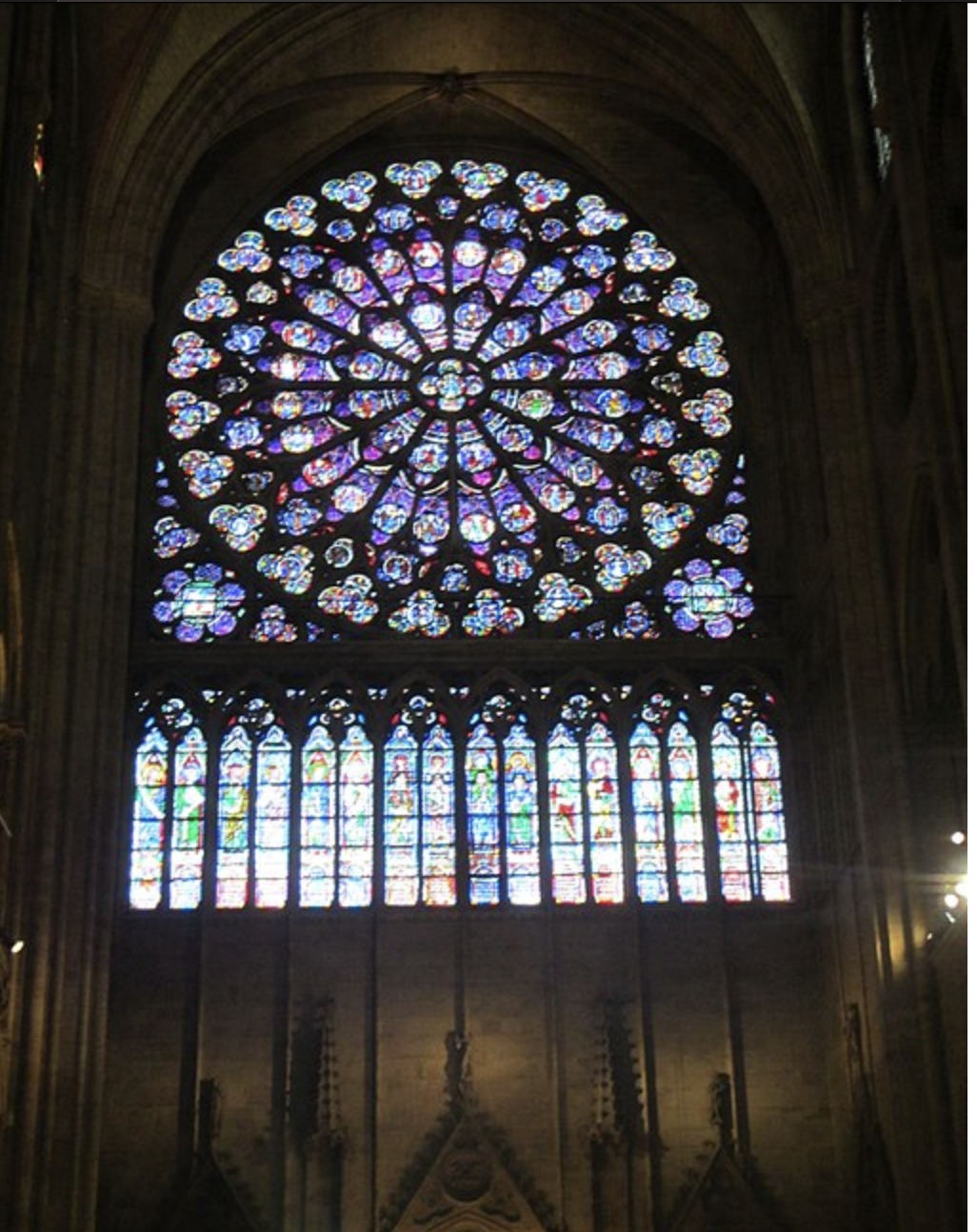
Notre Dame Rose Window in 2014. Image courtesy Jeremy Hylton via Wikimedia Commons.
That effort led by Voillet-le-Duc marked the most recent major renovation of Notre-Dame de Paris, but not its first major revamp. In 1699, the Cathedral received a major facelift in 1699, courtesy of the redecoration effort led by Hardouin Mansart and Robert de Cotte. Prior to that, several reconstruction and renovation efforts occurred, including the installment of the north and south rose windows.
In fact, the entire conception of Notre-Dame de Paris as we know it was the result of a major reconfiguration of sacred space. The original construction of Notre-Dame de Paris, commissioned by Bishop Maurice de Sully in 1163, replaced a demolished 4th century Cathedral of Saint Étienne. In that sense, one could argue that Notre-Dame de Paris has been an HGTV special from Day One.
The Future of Notre-Dame
Will this next reveal mark the final glow-up of this storied monument’s life? Or is this version of Notre-Dame de Paris simply another notch in the belt of this hero’s journey? If anything, this is a cathedral that has proved it knows how to reinvent itself and start anew. Plus, with the aid of new technology, the state-of-the-art Cathedral will be even more regal than before. Hopefully, 2019 was the last time Notre-Dame de Paris will face a fire. A renewed and refreshed cathedral will be worth the wait – and will stand for many centuries to come as a symbol of courage and resilience in the face of inferno.





